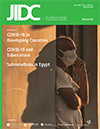The risk of public mobility from hotspots of COVID-19 during travel restriction in Bangladesh
DOI:
https://doi.org/10.3855/jidc.13104Keywords:
COVID-19, SARS-Cov-2, Outbreak, Hotspots, BangladeshAbstract
Bangladesh reported the first three laboratory-confirmed COVID-19 cases on March 8, 2020 in Dhaka and Narayanganj cities. As of April 8, 2020, 218 confirmed cases across the country, they have mostly detected from Dhaka (56.4%) and Narayanganj (21%) cities where the hotspots of an outbreak of COVID-19 disease. There were 6 cases in Dhaka district excluding metropolitan areas and rest of 43 (20%) cases in the 19 other regions. Local government-enforced completely shut down the hotspots areas on April 8 2020. However, peoples from hotspots travelled openly to the other districts.
We aimed to understand the risk of open movement from hotspots. We studied 40 individuals who were infected with SARS-CoV-2 virus later at their destination. We developed a route map and density maps using Geographic Information System (GIS). Among the studied people, the average distance was 140.1 (75.1) kilometers (Km), and the range of distance was from 20.3 to 321.7 kilometers. Among them, 42.5% traveled <100 Km, 40.0% traveled between 100 and 200 Km and 17.5% traveled above 200 Km. Case numbers were increased 13.5 times more on April 20 than the cases as of April 8, 2020.
Our analysis suggests that relaxed travel restriction could play an important role to spread COVID-19 transmission domestically. To reduce further spread of COVID-19, the government should closely monitor the public health intervention to stop the casual movement.
Downloads
Published
How to Cite
Issue
Section
License
Authors who publish with this journal agree to the following terms:
- Authors retain copyright and grant the journal right of first publication with the work simultaneously licensed under a Creative Commons Attribution License that allows others to share the work with an acknowledgement of the work's authorship and initial publication in this journal.
- Authors are able to enter into separate, additional contractual arrangements for the non-exclusive distribution of the journal's published version of the work (e.g., post it to an institutional repository or publish it in a book), with an acknowledgement of its initial publication in this journal.
- Authors are permitted and encouraged to post their work online (e.g., in institutional repositories or on their website) prior to and during the submission process, as it can lead to productive exchanges, as well as earlier and greater citation of published work (See The Effect of Open Access).








